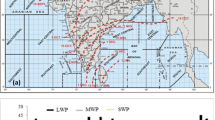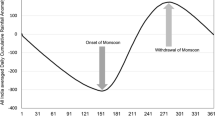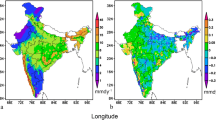Abstract
Indian monsoon is the most prominent of the world’s monsoon systems which primarily affects synoptic patterns of India and adjacent countries such as Iran in interaction with large-scale weather systems. In this article, the relationship between the withdrawal date of the Indian monsoon and the onset of fall precipitation in Iran has been studied. Data included annual time series of withdrawal dates of the Indian monsoon prepared by the Indian Institute for Tropical Meteorology, and time series of the first date of 25 mm accumulated precipitation over Iran’s synoptic weather stations in a 10-day period which is the basis for the cultivation date. Both time series were considered in Julian calendar with the starting date on August 1. The studied period is 1960–2014 which covers 55 years of data from 36 meteorological stations in Iran. By classifying the withdrawal dates of the Indian monsoon in three stages of late, normal, and early withdrawals, its relation with the onset of fall precipitation in western, southwestern, southern, eastern, central, and northern regions of Iran was studied. Results demonstrated that in four out of the six mentioned regions, the late withdrawal of the Indian monsoon postpones the onset of fall precipitation over Iran. No significant relation was found between the onset of fall precipitation in central region of Iran and the monsoon’s withdrawal date. In the western, southwestern, southern, and eastern regions of Iran, the late monsoon delays the onset of fall’s precipitation; while in the south Caspian Sea coastal area, it causes the early onset of autumnal precipitation. The lag in onset of fall precipitation in Iran which is coordinated with the late withdrawal of monsoon is accompanied with prolonged subtropical high settling over Iran’s plateau that prevents the southward movement of polar jet frontal systems. Such conditions enhance northerly wind currents over the Caspian Sea which, in turn, increase the precipitation in Caspian coastal provinces, which has a different behavior from the overall response of Iran’s climate to the late withdrawal of monsoon. In the phase of early monsoon withdrawal, the subtropical jet is located at the 200 hPa level in 32.5° north latitude; compared with the late withdrawal date, it shows a 2° southward movement. Additionally, the 500 hPa trough is also located in the Eastern Mediterranean, and the MSL pressure anomaly is between − 4 to − 7 hPa. The Mediterranean trough in the late withdrawal phase is located in its central zones. It seems that the lack of significant correlation between late withdrawal date of Indian monsoon and late fall’s precipitation onset in the central region of Iran depends on three reasons:
1. Lack of adequate weather stations in central region of Iran.
2. Precipitation standard deviations over arid and warm regions are high.
3. Central flat region of Iran without any source of humidity is located to the lee side of Zagros mountain range. So intensification or development of frontal systems is almost prohibited over there.







Similar content being viewed by others
References
Alijani B (2001) Climate of Iran. University press, Payame Noor, 221pp
Alijani B, Jafarpour Z, Bidokhti AA, Mofidi A (2008) Synoptic analysis of circulation patterns of monsoonal precipitation over Iran in June 1994. Iranian J Geol Sci 7(10):7–38
Azimzadeh M, Taliei AA (2010) Analysis of precipitation aiming to utilization of rain fed planning over north Khorasan-Iran. Iranian J Dry and Drought 25:41–51
Azizi G, Shamsipour A, Miri M (2013) Synoptic analysis of the relationship between frost fiers in Russia 2010 and Pakistan flood. Iranian J Geogr Dev 29:131–144
Babaeian I, Karimian M (2011) Pakistan flood: regional consequences of climate change. Technical report of Climate Research Institute, 12pp
Choudhury AD, Krishnan R (2011) Dynamical response of the south Asian monsoon trough to latent heating from stratiform and convective precipitation. J Atmospheric Sci 68:1347–1363
Donat MG, Lowry AL, Alexander LV, O’Gorman PA, Maher N (2016) More extreme precipitation in the world’s dry and wet regions. Nat Clim Chang 6:508–513
Gadgil S (2003) The Indian monsoon and its variability. Annu Rev Earth Planet Sci 31:429–467. https://doi.org/10.1146/annurev.earth.31.100901.141251
Gautman DK, Regmi SK (2013) Recent trends in the onset and withdrawal of summer monsoon over Nepal. ECOPERSIA 1(1):353–367
Ghaemi H (2012) General meteorology. SAMT press, Tehran, 592pp
Ghaemi H, Zarrin A, Azadi M, Farajzadehasl M (2010) Spatial analysis of subtropical high pressure over Asia and Africa. Quarterly J human Sci 13(1):219–245
Ghaemi H, Zarrin A, Khoshakhlagh F (2013) Climate of arid regions. SAMT press, Tehran, 419pp
He H, McGiness JW, Song Z, Yanai M (1987) Onset of Asian monsoon in 1979 and the effect of the Tibetan plateau. Mon Weather Rev 115:1966–1995
Hsu HH, Terng CT, Chen CT (1999) Evolution of large-scale circulation and heating during the first transition of Asian summer monsoon. J Clim 12:793–810
Jabbari A (2014) Statistical methods in environmental science and geography (3rd ed.). Razi University press, 294pp
Krishnamurti TN, Ardanuy P (1980) The 10–20 day westwardpropagating mode and breaks in monsoon. Tellus 32:15–26
Li C, Yanai M (1996) The onset and inter-annual variability of the Asian summer monsoon in relation to land–sea thermal contrast. J Clim 9:358–375
Luo H, Yanai M (1984) The large-scale circulation and heat sources over the Tibetan plateau and surrounding areas during the early summer of 1979. Part II: heat and moisture budgets. Mon Weather Rev 112:966–989
Modarres R (2007) Regional rainfall distribution of Iran. Iranian J Pajouhesh and Sazandegi 75:86–91
Mofidi A, Zarrin A (2013) Nature, structure and temporal variation of large scale summer circulation over West Asia. J Climate Res 3(11):15–40
Murakami T, Ding Y (1982) Wind and temperature change over Eurasia during the early summer of 1979. J Meteorol Soc Jpn 60:183–196
Nazemossadat MJ, Ghasemi AR (2004) Relationship between cold season precipitation of central and south west Iran and ENSO. Iranian J Agricultural Sci Technol Natural Res 7(3):1–13
Singh N, Ranade A (2010) Determination of onset and withdrawal dates of summer monsoon across India using NCEP/NCAR re-analysis. Indian Institute for Tropical Meteorology, Research report no RR-124. ISSN 0252-1075, 83pp
Vellore RK, Krishnan R, Pendharkar J, Choudhury AD, Sabin TP (2014) On the anomalous precipitation enhancement over the Himalayan foothills during monsoon breaks. Climate Dynamics: 43:7–8
Yanai M, Li C, Song Z (1992) Seasonal heating of the Tibetan plateau and its effect on the evolution of the Asian summer monsoon. J Meteorol Soc Jpn 70:319–351
Yarahmadi D, Azizi G (2008) Multi-parameters analysis aiming to investigate the relationship between seasonal precipitation of Iran and tele-connection indices. Iranian J Geogr Res 62:161–174
Author information
Authors and Affiliations
Corresponding author
Rights and permissions
About this article
Cite this article
Babaeian, I., Rezazadeh, P. On the relationship between Indian monsoon withdrawal and Iran’s fall precipitation onset. Theor Appl Climatol 134, 95–105 (2018). https://doi.org/10.1007/s00704-017-2260-0
Received:
Accepted:
Published:
Issue Date:
DOI: https://doi.org/10.1007/s00704-017-2260-0




